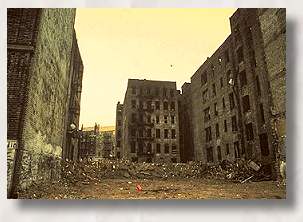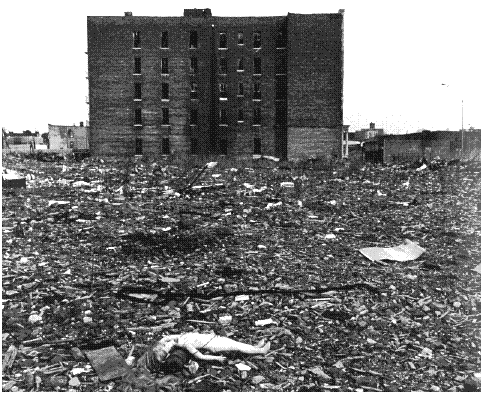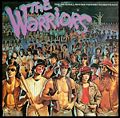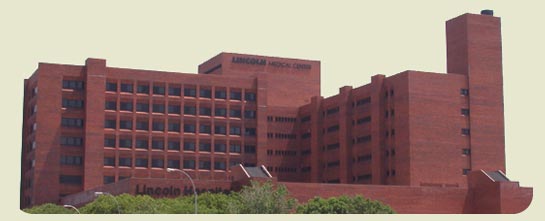From The Peopling of New York City
The 70s and 80s were years of great destruction for the Bronx. Due to rampaging fires and the prevalent drug use, this pillar of New York was being battered from all sides. It is for this reason that we chose Crumbling Pedestal to be the name of our group.
Contents |
View of the Neighborhood
Gallery Of Images
Group Members
Emily Park * Angela Y. Ho * Richard Esposito * David Weiss
'Institution Choice: Lincoln Medical and Mental Health Center'
We choose this institution because we feel that during the turbulent times of the 1970’s, this must have been a place of vital importance. With thousands of fires annually, this institution must have helped heal many wounded patients. Some scars are not physical but rather psychological and this institution treated these invisible illnesses as well. Our goal is to understand patient treatment during this period and to learn of the South Bronx from the hospital's perspective.
Institution Report
History, role in the neighborhood,
Prior to going to the Lincoln Medical and Mental Health Center, we decided to do some research on this significant institution. Founded in 1839 in Manhattan, it has been a crucial factor in the treating of African-American patients. The original founders were members of the "Home for the Relief of Aged Indigent Black Persons." The goal was to create an excellent place to treat colored people who were often the victims of the racial segregation of that era. While not entirely a hospital, this increasingly became the key component of the institution. By 1882, the hospital changed its name to “The Colored Home and Hospital.” By 1895, the hospital relocated to the Bronx, corresponding to the natural trend to that region. At the time it was considered to be a state-of-the-art facility in the medical field. By the 20th century, the hospital began to treat the ill regardless of race. As a demonstration of racial equality, the hospital changed its name to honor the president given credit for emancipating the slaves. In 1925, the board of trustees of the hospital was dealing with economic hardship and decided to sell Lincoln Hospital to the Department of Public Welfare of the City of New York. During the Second World War, Lincoln Hospital suffered a tremendous loss of doctors, who went abroad to help in the war effort. Shortly after the end of the war the neighborhood began to show a demographic shift. The white and Jewish populations began to leave the area and people from Latin America, the Caribbean and African-Americans began to populate the area. Despite the decline of the South Bronx during the 70’s the hospital was receiving a very positive reputation. Its Emergency Room was notoriously busy and it became one of the primary teaching hospitals in the New York area. While residence of the Bronx had a disproportionately high rate or illnesses asthma, Lincoln Hospital began experimenting with new methods of controlling the illness. In recent years Lincoln Hospital was credited by the New York State Department of Health as highly qualified with treating diabetes, heart disease and surgery. After doing much research on The Lincoln Medical and Mental Health Center, we went for an interview. We received an interview with a receptionist named Ms. Walker via telephone. We began the interview by asking her view on the history of the institution. Ms. Walker took much pride in describing the hospital as an institution servicing the South Bronx for over a century. It has long had a reputation for caring for people regardless of race. “I personally was not working at the hospital when the Bronx was burning, but the hospital has taken care of the sick and trained professionals during that time period.” Said Ms. Walker. Never the less she was very familiar with the Bronx during the ‘Bronx is burning’ period. When we asked about the treatment during the 1970’s, she reiterated that she was not employed by the hospital but said, “I can tell you that Lincoln was offering all necessary services in all divisions including mental health care. I imagine there was a large drug problem during the 70's, but that still affects young people today.” She stressed the mental health part of the name, indicating that the hospital was forced to treat traumatized victims of the Bronx fires as well as the expected patients of any urban population. The location was also deliberate. “The reason the hospital has been so important to everybody is because it is in a great location.” Said Ms. Walker. “We are on 149th Street right next to the Grand Concourse, it is a few blocks down the street...that is where the 4 train stops right now and it is a key location to serve the whole community of [the] South Bronx.” We continued the conversation about the revitalization of the South Bronx and how it relates to the hospital. Ms. Walker explained the current situation of the South Bronx, “Heart disease, diabetes, and asthma are the most prevalent health issues that affect people around the neighborhood... Many of these health problems are directly caused by a lack of healthy diet and exercise. [There's also no question] that the air in the Bronx is highly polluted. We do have to take insurance, but we always serve a few people for free as well.” After ending are interview we found it very enlightening to hear an inside report on the area during that time. It was also noteworthy to see how the hospital has changed and being that turmoil no longer reigns in the Bronx, treatment has adapted to the new reality. This helped us further our understanding of the Bronx during the 1970’s.
Institution Interview
1. Can we quickly go though the history of the institution? In the period of the "Bronx is Burning," where were you (as an institution) then and were are you now?
Ms. Walker -Lincoln hospital was founded in 1899, but the hospital itself was serving the people of the Bronx since the early 1800's. You have to also remember that we are in the new Lincoln. The old Lincoln is two miles away from here. The hospital has a long history of serving all people regardless of color. The hospital experienced a decline during and after WWII as doctors in the area were sent overseas and the social changes in the South Bronx were going on, as the white population moved out and African Americans and Latin Americans moved in. I personally was not working at the hospital when the Bronx was burning, but the hospital has taken care of the sick and trained professionals during that time period. Today, we specialize in the medical problems that commonly affect the people in this borough.
2. What is the hospital's point of view on the South Bronx, then and now? - The reason the hospital has been so important to everybody [in the South Bronx] is because it is in a great location. We are on 149th Street right next to the Grand Concourse, it is a few blocks down the street...that is where the 4 train stops right now and it is a key location to serve the whole community of [the] South Bronx.
3. This institution treated invisible illnesses as well.
- How did the hospital go about treating mental illnesses at that time, and what diseases (physical/mental) did they treat related to the Bronx burnings?
Ms. Walker - Again, I was not personally involved with Lincoln hospital during the 70's, but I can tell you that Lincoln was offering all necessary services in all divisions including mental health care.
4.What is the most prevalent health problems that people from the area have then and now overall? Which factors of the South Bronx affected these health problems? Ms. Walker -Heart disease, diabetes, and asthma are the most prevalent health issues that affect people around the neighborhood... Many of these health problems are directly caused by a lack of healthy diet and exercise. [There's also no question] that the air in the Bronx is highly polluted. We do have to take insurance, but we always serve a few people for free as well. I imagine there was a large drug problem during the 70's, but that still affects young people today. There is a Substance Abuse center not far away on 140th Street, and drug abuse remains one of the most dangerous problems affecting young people today.
5. We've been talking mostly about the 'Burning 70's,' but what about the 'Rising'? What was the visible phenomena during that period of time from the hospital's point of view?
Ms. Walker -There has been development in the South Bronx in the past few years, and we aim to keep our quality of care to the highest standard as possible, it does not matter what the rest of the neighborhood looks like or what kind of people are moving in. Thank you so much for your help.
- The answers of all the questions are revised to make it concise.
- question #1 and a little bit of #2, I stole from Ms. Feit for the fact that it was a essential question; but definitely not the answer;;
South Bronx's Situation from 1970s and 1980s
Due: April 29 Demographics, economy, culture, and governance.
By the '70s and '80s, the current population picture of the South Bronx was already painted by the waves of Puerto Ricans, Dominicans, and African Americans that had moved in during the previous decades. The older Jewish and European constituencies had already departed for other horizons (such as the Upper West Side, Brooklyn, and the suburbs) in the white flight movement. Housing was an economic disaster as destructive fires, whether unintentional or sadistically planned by landlords, left neighborhoods and lives in shreds and displaced hundreds of thousands of people who had no choice but to find somewhere else to live.
Gang culture was at a high point, partly due to Robert Moses' monstrous projects and disregard for the negative effects and destruction they caused. If nothing else, gangs were a way for people to belong to something, and a source of protection because civilians were merely victims without allies. On a more positive note, the foundations of hip hop and its culture were being laid by musical pioneers like Afrikaa Bambattaa and Grandmaster Flash, charismatic personalities who could rule entire neighborhoods with their sound systems. Rap and breakdancing began to gain precedence as forms of personal expression, less harmful than gang camaraderie and more social than graffiti. The hot new cliques were not gangs but breakdance crews.
The last few years of Mayor John Lindsay's tumultuous administration were plagued by strikes like the famous Hard Hat Riot in protest of the Vietnam War, the garbage workers' strike, and by a strike carried out by the bridge and maintenance workers. Abraham Beame succeeded him and fared even worse. During Beame's mayoralty, the City teetered on the edge of bankruptcy, barely surviving its worst financial crisis, and suffered through the 1977 blackout and related looting. Under the next mayor, Ed Koch, the city came back from the fiscal crisis and experienced an economic boom through the 1980s.
Impressions of the South Bronx Part Two
After spending a semester studying the South Bronx, I can honestly say that my opinion has undergone a full turnaround. Prior to my study, I was terrified of the neighborhood, but now I am intrigued and would want to continue casual study of the area. What was once seen as a center of violent crime is now seen as a place of working and middle class people trying to pursue the American dream.
I enjoyed the paper on the South Bronx in which we were instructed to ask about people's impressions of the area. When I asked my grandfather about how he sees the neighborhood, he reflected upon its once vibrant Jewish community. While I knew that the Bronx has a large Jewish community today in Riverdale, I did not know that at one point, Jews comprised approximately 50% of the borough. Being that I felt an ancestral connection, I had a newfound interest.
After feeling this connection, my goal was to figure out how the South Bronx went from being half Jewish to a place with no functional synagogues. Of course, this can be answered in long history textbooks. My impression is that the Jewish flight has a direct correlation to the white flight. Also, many Jewish people lost their homes when the Cross Bronx was built and left the borough. With the increase in violent crime, many young Jews left and went to the suburbs.
During the 1970's many buildings were burnt to the ground and the Bronx was in shambles. This gave the impression that the South Bronx was a dangerous place and people felt that it was worth being far away. By the 1990's the city began a rebirth and the crime rate citywide dropped. With the increase in tourism and the booming economy, the city, including the South Bronx, was on the rise. This was evident on our walking tour of the neighborhood. It was clear that the South Bronx is well on its way to being a vital place in New York as it once was. Granted the demographics are different but that is what makes New York such an outstanding city.
My last impression of the South Bronx came at Yankee Stadium. Prior to the game, I went on a 'scalping' mission with my friend and now business associate, Dennis Kim. The goal was to scalp two extra tickets to the bleachers. Being that the mission was only a partial success, I would prefer not to over analyze my lack of salesmanship. Instead I found it amazing as to how the process worked. Being that it is illegal, we began by going far from the stadium. With no luck, we got closer and found people who wanted the tickets but for much less then face value. I refused to budge but Dennis sold his ticket. Unfortunately he made a mere $2.00 and I was left with one useless ticket. I found it amazing to be involved in the black market. It was educational to learn the code words and lingo. Perhaps next time, I will actually make a sale.
Once at the game I got a taste of the notorious "bleacher creatures." With a reputation of being rowdy and knowledgeable fans, I entered Yankee Stadium with Red Sox apparel. To my disappointment, very few fans engaged me in a battle of wits. Never the less, the game was an enjoyable experience, despite a Yankee victory. Want to race through your inbox even faster? Try the full version of Windows Live Hotmail
-Emily Park,Angela Y. Ho,Richard Esposito,David Weiss



















